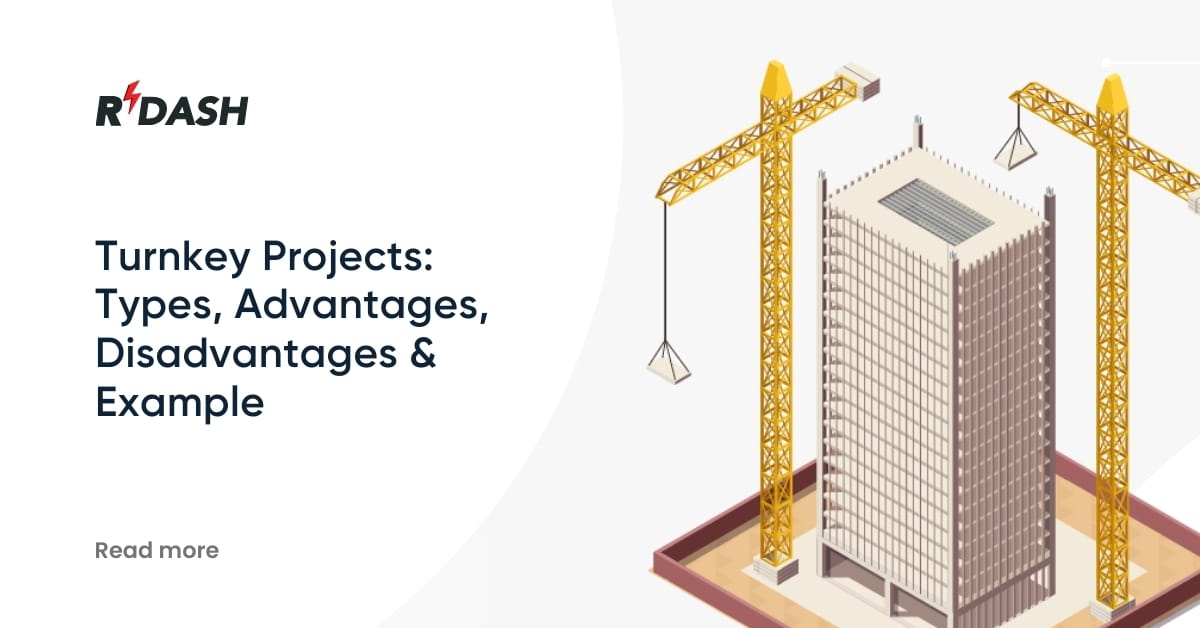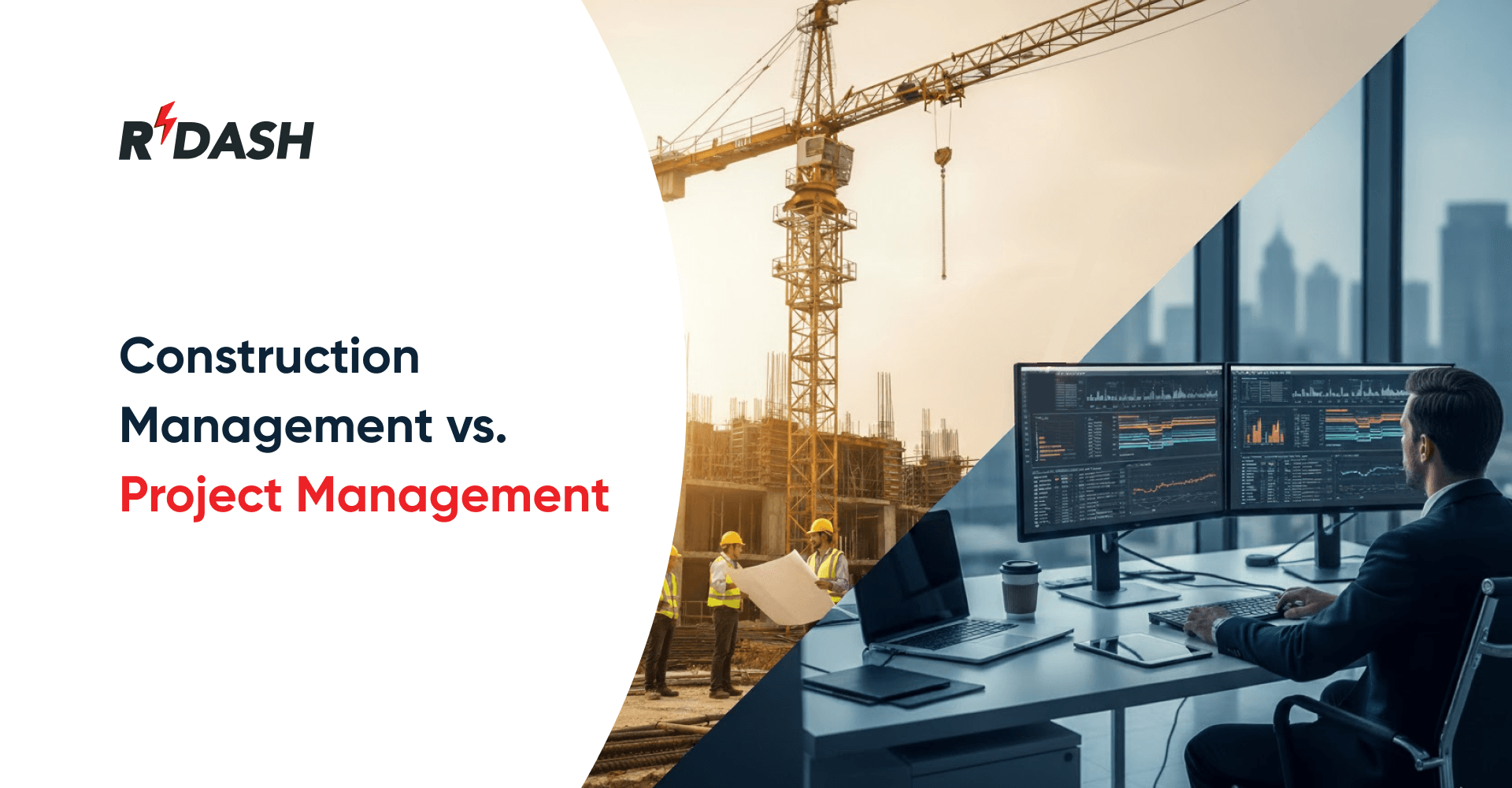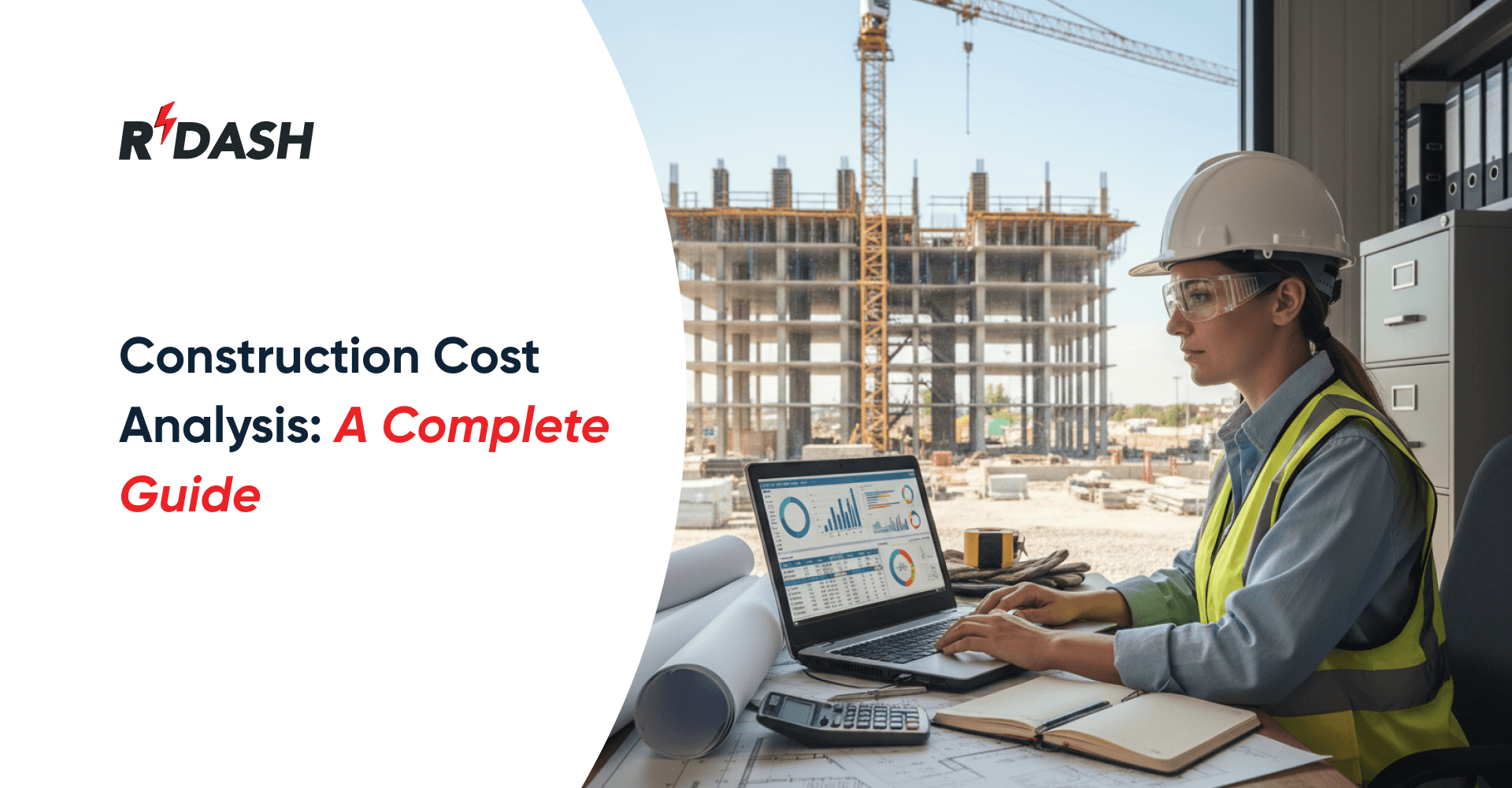A turnkey project is a comprehensive solution managed by a contractor who oversees all phases from concept to final delivery, ready for immediate operation. The contractor assumes full responsibility for design, procurement, construction, and commissioning, ensuring the project meets the client’s specifications. This model simplifies project management for clients, offering efficiency and convenience with a single point of accountability, often leading to expedited completion and cost savings. Turnkey projects are common in construction, manufacturing, and IT, providing a fully operational product or facility with minimal client involvement, allowing clients to focus on their core business activities.

What is a Turnkey Project?
A turnkey project is a project delivery method where a contractor or firm assumes full responsibility for managing the entire project lifecycle, encompassing initial concept and design through to construction and final delivery. The term “turnkey” signifies that the client can “turn the key” to a fully operational facility upon project completion, with minimal involvement required during the execution phase. This model guarantees that all project components align with the client’s specifications and requirements, providing a seamless and hassle-free experience.
In a turnkey project, the contractor takes on the role of a trusted partner, ensuring that every detail is meticulously planned and executed. The client benefits from the contractor’s expertise, industry knowledge, and established processes, which streamline project management and reduce risks. By fostering a collaborative relationship, the contractor ensures that the client’s vision is realized to the highest standards of quality and efficiency. This approach not only enhances the client-contractor relationship but also delivers a superior outcome, making turnkey projects an attractive option for clients seeking reliability, professionalism, and excellence in project execution.
Types of Turnkey Projects
Turnkey projects are comprehensive solutions where a single contractor manages the entire process from design to completion, delivering a fully operational facility. In the Indian construction sector, these projects are gaining traction due to their efficiency, cost-effectiveness, and convenience. Here are the primary types of turnkey projects relevant to the Indian construction industry :
Residential Turnkey Projects : Residential turnkey projects encompass the design, construction, and completion of housing units, such as apartments, villas, and gated communities. The contractor handles everything from architectural planning and material procurement to interior finishing and landscaping. This approach is particularly appealing to real estate developers and individual homebuyers seeking hassle-free, ready-to-move-in homes.
Commercial Turnkey Projects : These projects involve the development of commercial spaces like office buildings, shopping malls, and retail complexes. The contractor ensures that all aspects, including structural integrity, electrical systems, plumbing, HVAC, and interior design, are completed to the client’s specifications. For businesses and investors, this offers a seamless transition to a fully functional commercial property.
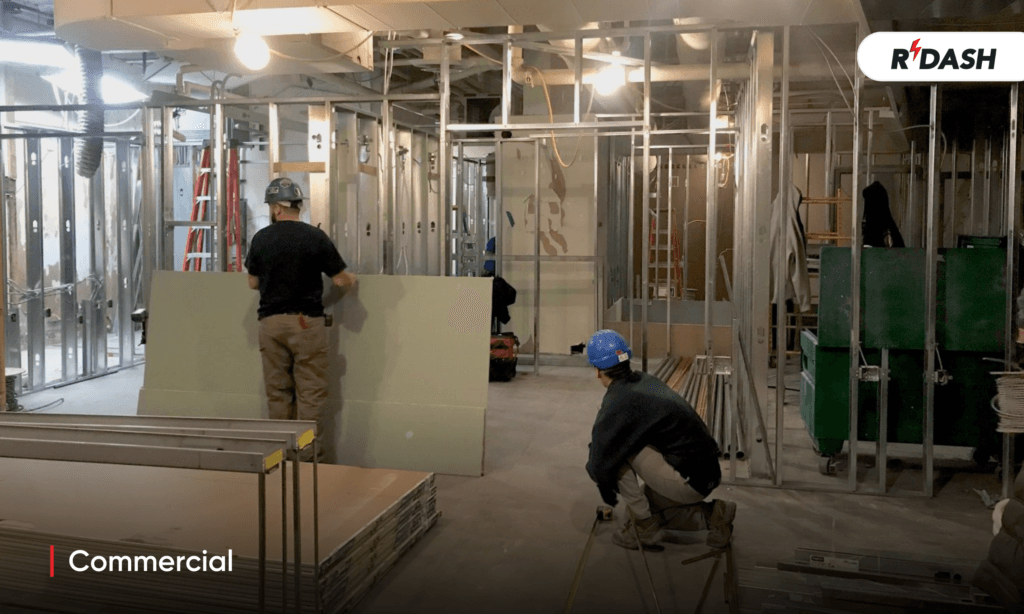
Industrial Turnkey Projects : Industrial turnkey projects are comprehensive solutions for setting up manufacturing plants, warehouses, and other industrial facilities. These projects require specialized expertise in industrial engineering, safety standards, and regulatory compliance. Contractors handle the entire process, including site selection, plant layout, machinery installation, and commissioning, ensuring the facility is operational from day one.
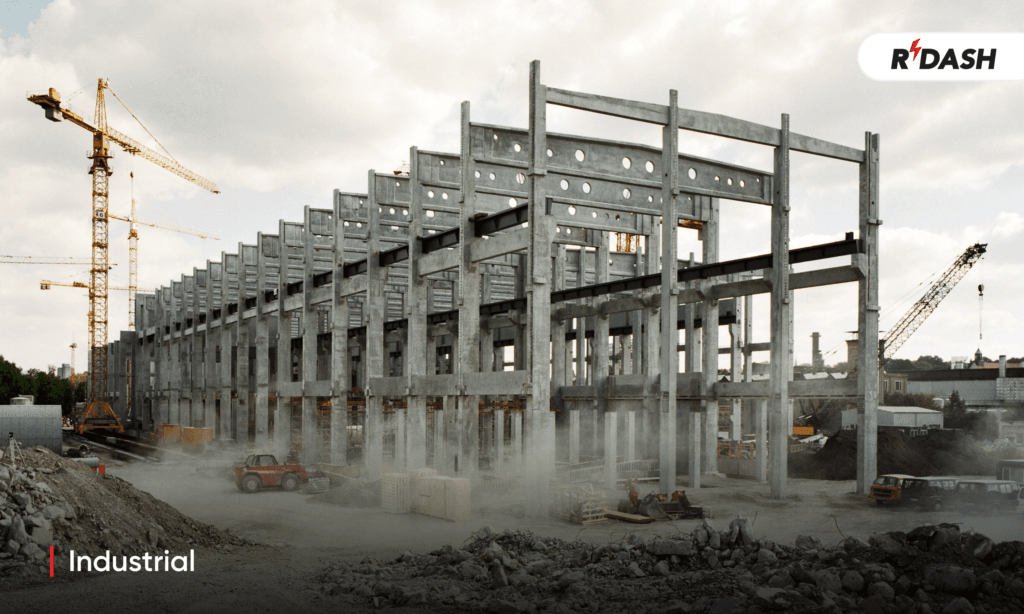
Infrastructure Turnkey Projects : Infrastructure turnkey projects cover the development of essential public infrastructure such as roads, bridges, airports, and railway stations. Given the scale and complexity of such projects, turnkey solutions ensure that all phases, from initial feasibility studies and environmental clearances to construction and final handover, are managed by a single entity. This approach minimizes delays and ensures adherence to quality standards and timelines.
Healthcare Turnkey Projects : Healthcare turnkey projects focus on the construction of hospitals, clinics, and medical facilities. These projects require adherence to stringent healthcare regulations and standards. Contractors manage all aspects, including medical equipment installation, facility design for patient care efficiency, and compliance with health and safety norms. This allows healthcare providers to offer immediate and high-quality services upon completion.

Hospitality Turnkey Projects : In the hospitality sector, turnkey projects involve the construction of hotels, resorts, and service apartments. The contractor is responsible for everything from architectural design and construction to interior decor and amenities installation. This ensures that hospitality businesses can quickly begin operations, providing guests with a fully equipped and aesthetically pleasing environment.
Detailed Steps in Turnkey Project Development
Understanding the detailed steps involved in turnkey project development provides a comprehensive overview of how these projects are effectively managed and executed, ensuring a smooth transition from concept to completion.
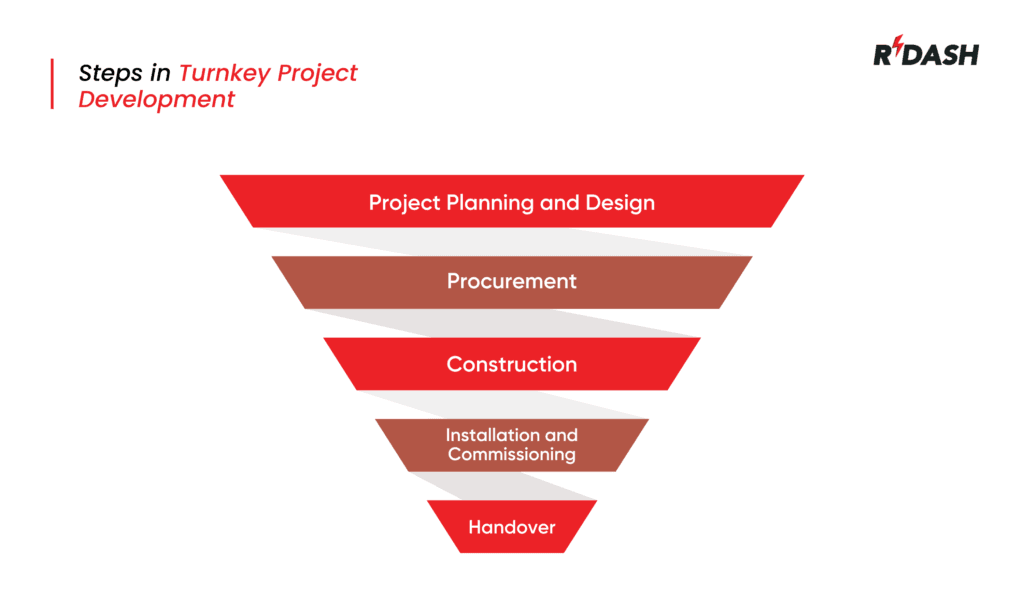
- Project Planning and Design : The first step in turnkey project development is meticulous planning and design. Contractors engage in close collaboration with clients to gain a deep understanding of their needs and objectives. This phase involves creating detailed project plans, architectural designs, and technical specifications, as well as securing all necessary permits and approvals. Effective planning sets the foundation for the project, aligning stakeholder expectations and establishing a clear roadmap for execution.
- Procurement : Following the planning and design phase, the contractor moves into the procurement stage. This involves sourcing all necessary materials, equipment, and services in accordance with the project’s standards and specifications. The contractor’s established relationships with suppliers can expedite the procurement process, ensuring timely delivery and cost-effective sourcing. This proactive approach minimizes delays and enhances the overall efficiency of the project.
- Construction : During the construction phase, the contractor oversees all aspects of the building process, ensuring compliance with the approved designs and specifications. This involves coordinating subcontractors and suppliers to ensure high-quality workmanship and efficient progress. Regular site inspections and progress reports facilitate effective communication and timely issue resolution, further enhancing project delivery. The contractor’s role as a central point of coordination ensures that all elements align seamlessly, minimizing disruptions and maintaining momentum.
- Installation and Commissioning : Once construction is complete, the contractor transitions to the installation and commissioning phase. This critical step involves ensuring that all equipment and systems are installed correctly and are fully operational. Thorough testing and validation are conducted to confirm that the project meets established performance criteria and complies with regulatory standards. This rigorous attention to detail ensures that the facility is not only functional but also optimized for operational efficiency.
- Handover : The final step in a turnkey project is the handover process. Once the contractor has ensured that the facility meets all client specifications and operational requirements, they formally transfer ownership to the client. This handover is accompanied by comprehensive documentation, including operation manuals, maintenance guidelines, and warranties. The client can begin immediate use of the facility, confident that it is fully operational and meets their expectations. This smooth transition underscores the contractor’s commitment to delivering value and excellence throughout the project lifecycle.
Advantages of Turnkey Projects
Turnkey projects provide numerous advantages, making them an appealing option for a variety of clients across different industries. Here are some key benefits:
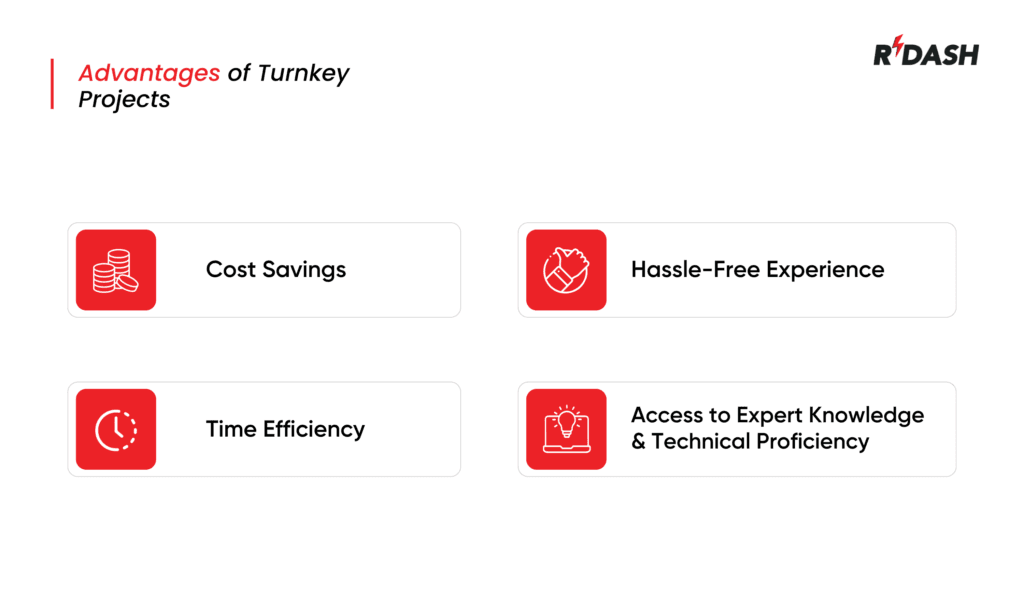
- Cost Savings : Turnkey projects often deliver substantial cost savings through fixed-price contracts that shield clients from potential cost overruns. By assuming the risk of additional expenses, contractors help ensure that projects remain within budget. This predictability in financial planning allows clients to allocate resources more effectively and manage their budgets with greater confidence.
- Time Efficiency : Another significant advantage of turnkey projects is the time efficiency they offer. By allowing contractors to manage all aspects of the project—from design and procurement to construction and commissioning—clients can focus on their core business activities. This streamlined approach often results in quicker project completion, enabling businesses to expedite their operational capabilities and capitalize on new opportunities more rapidly.
- Hassle-Free Experience : The hassle-free nature of turnkey projects is a major benefit for clients. Contractors handle all project details, including securing necessary permits, coordinating subcontractors, and managing logistics. This alleviates the burden on clients, allowing them to direct their attention toward other critical tasks. The comprehensive management provided by the contractor ensures that clients experience minimal disruptions during the project lifecycle.
- Access to Expert Knowledge and Technical Proficiency : Turnkey projects grant clients access to a wealth of expert knowledge and technical know-how. Contractors bring extensive experience and industry expertise, ensuring high-quality project completion and adherence to best practices. This is particularly beneficial for clients who may lack in-house expertise or resources to manage complex projects. The contractor’s proficiency not only enhances project outcomes but also fosters innovation and efficiency.
Disadvantages of Turnkey Projects
While turnkey projects present numerous advantages, it is essential for clients to be aware of potential drawbacks that may impact their decision-making process. Understanding these challenges allows clients to make informed choices that align with their strategic objectives.
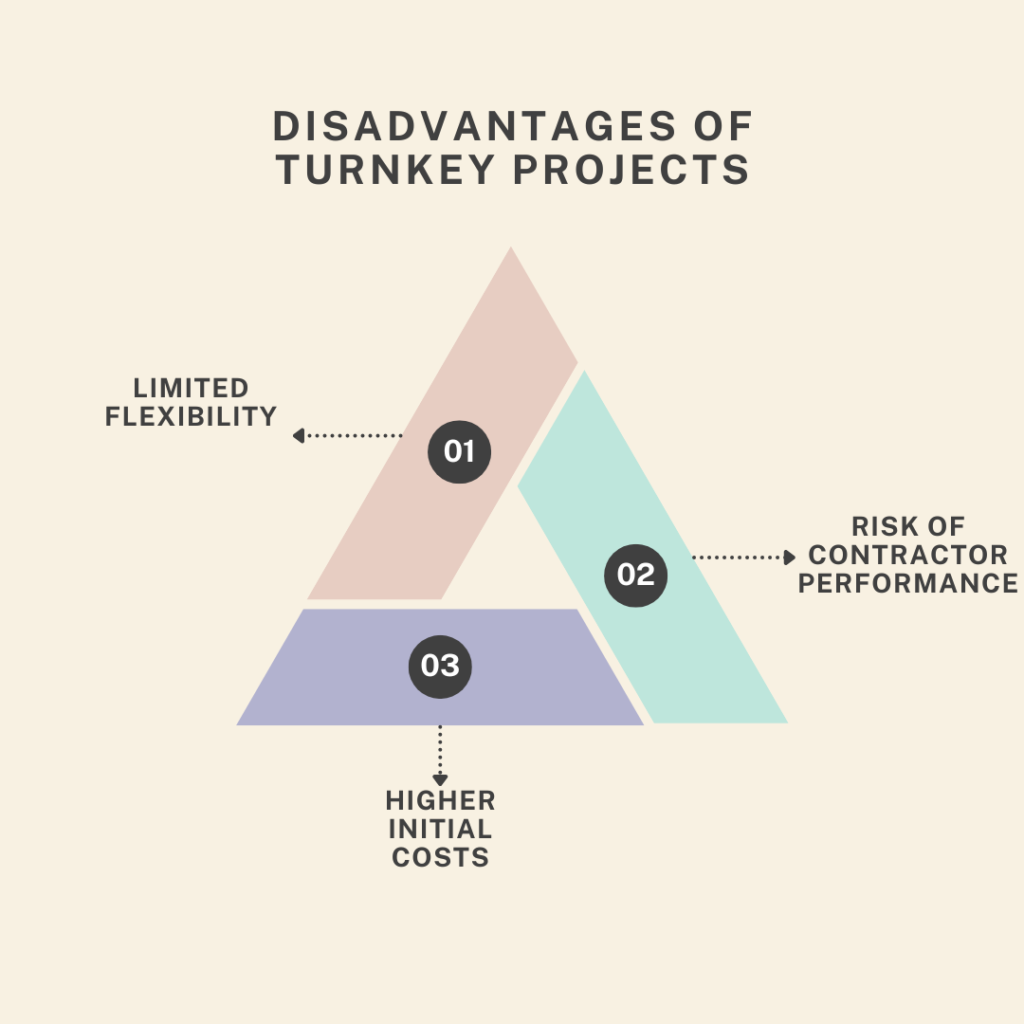
- Limited Flexibility : One significant drawback of turnkey projects is their inherent limited flexibility, primarily due to the nature of fixed-price contracts. Clients must provide clear and detailed initial requirements to avoid complications during execution. Any changes or modifications that arise post-agreement can lead to additional costs and delays, making it critical for clients to thoroughly define their project scope and specifications upfront.
- Risk of Contractor Performance : The success of a turnkey project is heavily dependent on the contractor’s performance and reliability. Selecting a reputable and experienced contractor is paramount to mitigating risks associated with project delivery. Inadequate contractor performance can lead to missed deadlines, subpar quality, and ultimately, client dissatisfaction. Conducting thorough due diligence during the contractor selection process—such as reviewing past projects, client testimonials, and industry credentials—can help ensure that clients partner with a capable contractor committed to delivering high-quality results.
- Higher Initial Costs : Turnkey projects may also involve higher initial costs, as contractors assume all risks and responsibilities associated with project execution. While these upfront costs can seem daunting, they are often counterbalanced by the benefits of cost certainty and reduced financial risk for the client. The fixed-price nature of turnkey contracts means that clients can avoid unexpected expenses, allowing for better budget management and financial planning.
Turnkey Projects Examples
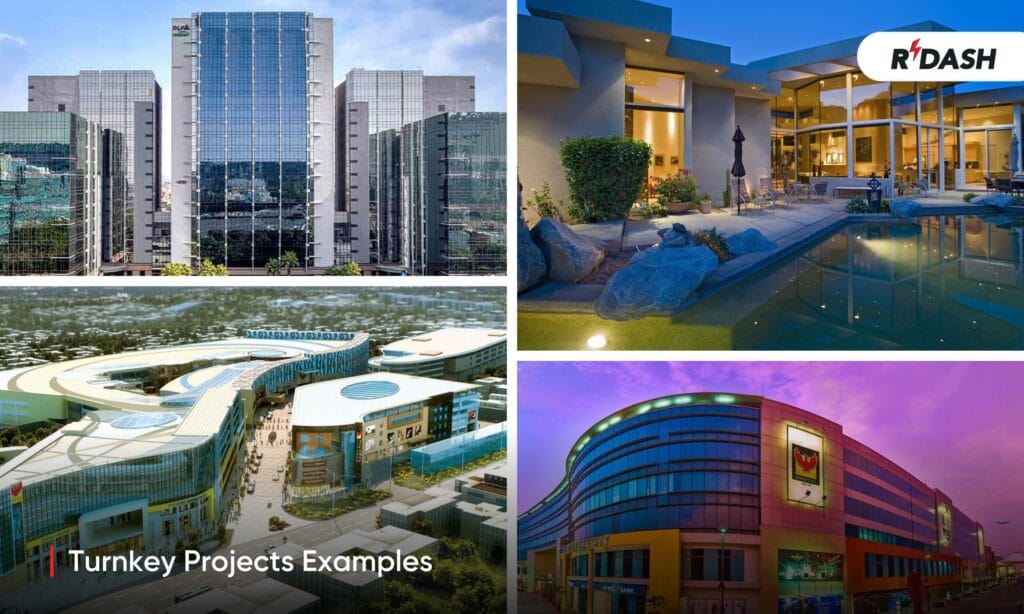
- DLF Cyber City, Gurgaon : DLF Cyber City in Gurgaon stands as a testament to the effectiveness of turnkey projects. This prominent commercial hub includes office spaces, retail outlets, and recreational facilities, all completed by a single contractor to ensure flawless integration and functionality.
- Tata Steel Plant, Kalinganagar, Odisha The Tata Steel Plant in Kalinganagar, developed as a turnkey project, showcases the scope and scale achievable through this model. The project encompassed the construction of a state-of-the-art steel manufacturing facility, complete with machinery installation, infrastructure development, and stringent compliance with environmental and safety regulations.
- Delhi Metro Rail Project The Delhi Metro Rail Corporation (DMRC) leveraged the turnkey model for various phases of the metro rail project. This approach ensured efficient project management, timely completion, and adherence to international safety and quality standards, revolutionizing urban transportation in the capital.
- AIIMS, Raipur The All India Institute of Medical Sciences (AIIMS) in Raipur was developed as a turnkey project, including the construction of hospital infrastructure, installation of medical equipment, and ensuring compliance with stringent healthcare standards, thus providing a fully functional medical facility.
- Phoenix Marketcity, Mumbai Phoenix Marketcity in Mumbai, a sprawling shopping mall, was developed as a turnkey project. The comprehensive execution included the design, construction, and fit-out of retail spaces, entertainment zones, and dining areas, providing an exceptional shopping experience.
- Reliance Jio 4G Network Rollout Reliance Jio’s nationwide 4G network rollout exemplifies the power of turnkey projects in the telecom sector. The project involved setting up an extensive telecommunications infrastructure, including towers, fiber optic networks, and data centers, ensuring seamless connectivity across the country.
Essential Elements of a Turnkey Contract
Scope of Work
The scope of work is arguably the most critical element of a turnkey contract.It clearly outlines what the project involves and how detailed it needs to be, specifying exactly what work will be done, the standards to be met, and the deliverables expected at the end of the project. This clause ensures all parties have a clear understanding of what the project entails, including detailed descriptions of tasks, materials, services, and the final objectives. This clarity helps in avoiding disputes over expectations and deliverables.
Performance Criteria
This section of the contract specifies the performance criteria that the completed project must meet. It is essential for ensuring the facility operates according to the project owner’s requirements. Performance specifications can include operational outputs, efficiency levels, and quality standards that the contractor must achieve. This clause often incorporates testing procedures to verify that the performance standards are met before the project is considered complete.
Payment Terms
Turnkey projects often operate on a fixed price basis, which means the contractor agrees to complete the project within a set budget. This element is crucial as it provides financial certainty to the project owner. The payment terms section outlines the schedule for payments, which can be tied to project milestones or specific completion percentages. This setup incentivizes the contractor to meet project timelines and budgets while ensuring the owner pays for received and approved work, thereby maintaining cash flow and budget control.
Risk Allocation and Responsibilities
In turnkey contracts, it is essential to explicitly state which party bears which risks. This element covers the allocation of various project risks, including labor issues, material availability, regulatory changes, and unforeseen environmental conditions. Additionally, it outlines the responsibilities of each party in managing these risks. This clause helps in preventing disputes related to unexpected project challenges and clarifies who is liable for additional costs arising from such risks.
Project Timeline
The project timeline is a schedule outlining significant milestones and the final completion date. This element is critical for planning and resource allocation. It includes start and end dates for the project and may provide detailed schedules for the delivery of materials, phases of construction, and commissioning of the project. Adherence to the timeline is usually strictly enforced, with potential penalties for delays and incentives for early completion.
Clauses of Turnkey Contracts
Project Design
This clause forms the foundation of a turnkey contract, detailing the design responsibilities of the contractor. It outlines the precise requirements for the project’s outcome, specifying technical and operational specifications that must be met. This section ensures that the contractor fully understands the scope and expectations before commencing work, including any regulatory compliances and aesthetic considerations dictated by the client.
Performance Guarantees
To ensure that the completed project meets the operational standards agreed upon, performance guarantees are stipulated in this clause. These guarantees require the contractor to ensure that the facility performs at a specified efficiency or capacity before it is considered complete. If these criteria are not met, the contractor may need to make adjustments at their expense. This clause is crucial for providing the project owner with assurance that the completed facility will function as intended.
Completion Time
Timelines are crucial in turnkey projects. The completion time clause specifies when the project should be ready for handover, including key milestones and deadlines throughout the project lifecycle. This clause often incorporates schedules for each phase of the work, providing a timeline that the contractor must adhere to. Penalties for delays and incentives for early completion might also be included to ensure adherence to the timeline.
Construction Site
The construction site clause addresses the physical location where the project will be developed. It includes provisions for site access, utilization of local resources, handling of on-site issues, and sometimes, the responsibilities for obtaining necessary permits and dealing with local authorities. This clause is crucial for logistics planning and management, ensuring the contractor has unfettered access and clear guidelines for site operations.
Price and Payments
Financial terms are detailed in the price and payments clause, which is essential for defining the economic framework of the project. This includes the total project cost, payment schedules, and conditions under which payments are made. It might specify advance payments, progress payments based on milestones, and the final lump sum upon completion. This clause often details the financial penalties for non-compliance and adjustments in case of approved changes affecting the project scope.
RDash: Your Comprehensive Construction Management Solution
1. Recce (Site Survey)
- Purpose: Conducts detailed site surveys to capture measurements, site conditions, structural components, and markers for inlets and outlets around AC, electrical, and plumbing services.
- Key Features:
- Provides a comprehensive checklist for capturing all necessary details.
- Organizes data into a structured report for initial client interaction.
- Includes site survey training and assigns specific personnel to ensure accuracy.
2. Design Management
- Purpose: Manages the design development process, which includes concept development and the creation of Good For Construction (GFC) drawings.
- Key Features:
- Utilizes tools like AutoCAD, SketchUp, and Revit for design creation.
- Maintains a design management system to track design files, versions, and approvals.
- Coordinates effectively between site and design teams to avoid mismanagement and ensure timely execution.
3. Bill of Quantities (BOQ) Management
- Purpose: Defines the project scope by detailing item names, descriptions, quantities, rates, and costs for each item.
- Key Features:
- Continuously updates the BOQ to document changes and prevent revenue leakage.
- Creates a predefined catalogue of items and standard templates to minimize errors.
- Maintains status tracking against each BOQ line item for client approval and procurement coordination.
4. Order Management
- Purpose: Manages procurement processes, ensuring timely order placements and accurate vendor coordination.
- Key Features:
- Establishes an approval hierarchy for invoice acceptance and order releases.
- Uses element codes and procurement rate masters to automate reconciliation and maintain synchronization between project and procurement teams.
- Tracks procurement status for long lead items to prevent project delays.
5. Work Progress Tracking
- Purpose: Monitors site operations and project progress to ensure transparency and accountability.
- Key Features:
- Utilizes Daily Progress Reports (DPR) with visual proofs, manpower counts, blockers, and projected end dates.
- Tracks percentage completion and identifies patterns to detect potential issues early.
- Sends invoice alerts upon reaching payment milestones and conducts milestone reviews.
6. Snag Management and Audits
- Purpose: Ensures smooth project handover by addressing finishing gaps and customer feedback.
- Key Features:
- Records and addresses snags during practical handover to ensure customer satisfaction.
- Maintains snag lists with statuses and coordinates with clients for a snag-free final handover.
- Monitors the Defect Liability Period (DLP) to address minor issues post-occupancy.
7. Financial Management
- Purpose: Controls project finances, ensuring accurate margin tracking and cost management.
- Key Features:
- Assigns a unique JOB ID and creates a project wallet to manage cash flow.
- Implements a finance controller and approval mechanism for reimbursements.
- Integrates ERP with project management software to ensure accurate expense tagging and reconciliation.
8. Project Manager Task Master
- Purpose: Centralizes project management tasks and responsibilities to streamline operations.
- Key Features:
- Assigns tasks and tracks progress for project managers.
- Provides a comprehensive view of all ongoing projects and their statuses.
- Ensures timely completion of tasks and adherence to project timelines.
Why Choose RDash?
RDash brings all these essential functions together in a single app, ensuring seamless coordination and efficient management across all phases of construction projects. With RDash, you can expect:
- Enhanced Efficiency: Streamlined processes reduce time wastage and improve productivity.
- Improved Accuracy: Comprehensive checklists and templates minimize errors and ensure consistency.
- Greater Transparency: Real-time progress tracking and reporting keep all stakeholders informed and accountable.
- Financial Control: Rigorous financial management prevents cost overruns and ensures profitability.
- Customer Satisfaction: Effective snag management and timely handovers enhance client relationships and reputation.
RDash is your one-stop solution for all construction management needs, driving your projects to success with precision and professionalism.
Conclusion
Turnkey projects provide a streamlined and efficient solution for companies seeking to outsource the complexities associated with project development. By leveraging the expertise of third-party contractors, organizations can realize significant cost savings, enhance time efficiency, and achieve high-quality results. This model is particularly beneficial in sectors such as infrastructure, manufacturing, and real estate, where the intricacies of project execution can be overwhelming. Turnkey projects enable businesses to concentrate on their core operations while ensuring successful outcomes, as the contractor assumes full responsibility for managing every phase of the project.
A comprehensive understanding of the detailed steps involved in turnkey projects—including project planning, procurement, construction, installation, and final handover—is crucial for clients looking to navigate this approach effectively. Key features such as a single point of responsibility, fixed-price contracts, and performance guarantees enhance accountability and streamline communication, thereby reducing the risks typically associated with project management. However, it is essential for clients to be aware of potential drawbacks, such as reliance on the contractor’s expertise and the risk of misalignment with the client’s vision due to reduced day-to-day involvement.
By carefully selecting a reputable contractor with a proven track record and clearly defining their requirements, clients can maximize the advantages offered by turnkey projects. This strategic approach not only fosters successful project delivery but also builds long-term partnerships that contribute to sustained growth and innovation. Ultimately, embracing the turnkey model allows organizations to achieve operational efficiency and superior quality in project execution, ensuring they thrive in a competitive landscape while focusing on their primary business objectives.

